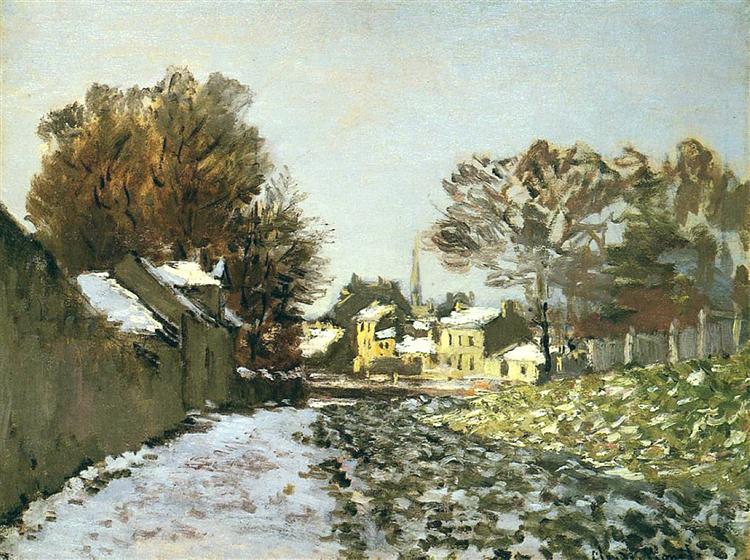Beschrijving
Claude Monet's painting "Snow at Argenteuil" (1874) is a masterful example of the Impressionist style that defines much of the artist's work and, by extension, the movement he helped found. Known for his ability to capture light and atmosphere, Monet employs a technique in this work that reflects his focus on the changing conditions of nature and the French rural landscape.
When looking at Snow at Argenteuil, it is evident that the viewer is transported into a winter landscape, where snow gently covers the ground, rooftops and trees. The composition of the work is effectively organised in terms of space and form, with a structure that develops in an almost diagonal manner, leading the viewer's gaze from the foreground, where footprints in the snow can be seen, to a background where houses and trees can be seen. This use of space is characteristic of Monet's focus on creating a sense of depth and atmosphere.
The palette used is predominantly cool, with an intense range of whites, blues and greys evoking the coldness of winter. However, Monet does not limit his application of colour to a simple monotonous representation of the winter landscape. Contrary to this, subtle nuances can be observed in the snow, where touches of blue and grey intertwine with pure white, suggesting the complexity of light on the snow. As the sunlight filters through the clouds, it creates a delicate glow that enlivens the scene and transforms it into a vibrant and dynamic environment, despite the cold.
Within the painting, human figures can be glimpsed, suggesting the everyday activity of life in Argenteuil during the winter. These figures, although tiny in comparison to the vast landscape, add a sense of scale and humanize the scene, offering a contrast to the vastness of the natural surroundings. Subtle movements of these figures can be discerned, whether someone is strolling or working in the fields, echoing Monet's commitment to depicting not only nature, but also human interaction with it.
It is interesting to note that "Snow at Argenteuil" was created at a time when Monet was experimenting with rapid, spontaneous execution, moving closer to capturing the immediacy of visual experience. This approach was seen in contemporary works of his and would become an essential characteristic of Impressionism.
The painting is set in Argenteuil, a village on the banks of the Seine, which was a recurring site in the work of Monet and other Impressionists. Through the depiction of this familiar setting, Monet not only documents the beauty of the place, but also establishes a dialogue between nature and the transformations of modern life. The inclusion of winter also introduces a sense of stillness and reflection, contrasting with the bustle of the expanding cities during the 19th century.
In short, Snow at Argenteuil is not just a depiction of a winter landscape, but a meditation on light, atmosphere, and the way the two interact with the natural and human world. It is a testament to Monet’s ability to condense a snapshot of life, seasons, and time, resonating with the viewer through its simultaneous simplicity and complexity. The work is in the same vein as many of his other explorations of landscape, such as Impression, Rising Sun and The Water Lilies, where the same principle of capturing the essence of a fleeting moment guides his hand. The significance of this work resonates not only in its aesthetics, but in the understanding and interpretation of the world it inhabits, cementing Claude Monet as a pivotal figure in art history.
KUADROS ©, a famous painting on your wall.
Hand-made oil painting reproductions, with the quality of professional artists and the distinctive seal of KUADROS ©.
Painting reproduction service with satisfaction guarantee. If you are not completely satisfied with the replica of your painting, we will refund 100% of your money.

